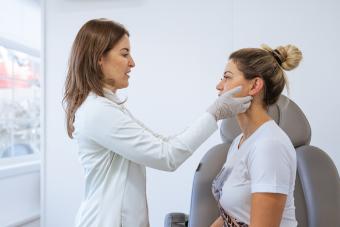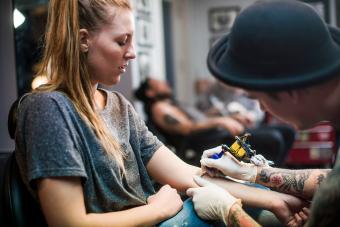
Nose piercings are a unique way to adorn your body and advertise your uniqueness, but they come with certain risk factors, including a nose keloid. Piercing your nose will not always result in a keloid. However, you should be aware of certain risk factors and treatment options before putting a ring in your nose.
What Is a Nose Keloid?
Maybe you got your nostril pierced or possibly your septum, and you've been following all the aftercare instructions. Your piercing was healing beautifully, but a few days ago, you noticed a shiny raised bump next to your nose ring. You could be experiencing a nose keloid.
According to the American Academy of Dermatology (AAD), a keloid is a raised scar that forms around a minor or major skin injury like a piercing. This is an abnormal type of healing where the fibrous tissue that creates the scar grows out of control and can extend beyond the area that was pierced.
Keloid Symptoms
Nose keloids can be tricky for you to self-diagnose because they can be similar to other types of skin problems. According to the AAD, some keloids can develop quickly and might mimic an infection. You might experience pain or tenderness in the lump, and it can also itch, which are common occurrences among infections from unsterilized equipment and allergic reactions to specific metals or cheap jewelry. Therefore, you should see a dermatologist or healthcare professional if you develop a lump. There are, however, some distinct symptoms of a typical nose keloid, stated AAD.
Unlike an infection or allergic reactions, a keloid can develop slowly over time, typically 3-12 months. Around a piercing, a keloid is typically a solid mass with a smooth, shiny appearance, and pink, purple, or brown in color. It will also be fixed in place, feel hard and rubbery, and become darker with time, stated AAD.
Nose Keloid Risk Factors
Keloids are bothersome and can cause unsightly scarring, but according to the Austin Journal of Dermatology, they aren't common in all people. There are several risk factors that can increase your likelihood of developing a nose keloid, including your melanin, family history, and blood type.
- Blood type: People with blood type A have a higher probability of keloid scars.
- Family history: There could also be a genetic predisposition due to a family history of keloid scars.
- Melanin: The Austin Journal of Dermatology noted a relationship between darker skin tones and keloid scars. This is theorized to be due to the increased melanin in the skin during healing.
How to Prevent Nose Keloid Scars
There are ways that you can treat a keloid once it develops, but the only way to prevent a keloid from a nose piercing is to not get the piercing at all. If you have a family or personal history of getting keloid scars, you might want to seriously consider getting the piercing.
However, if you choose to get the piercing, watch for the first signs of thickening on your skin. Once you start to notice thickening, remove the piercing and visit a dermatologist for options to avoid a full-blown nose keloid.

Treatment Options for Keloid Scars
Once a keloid has developed, you have treatment options that are available. Depending on your keloid and your healthcare professional, you might have to try out several to find the one that works best for you. The treatment options listed in The Journal of Clinical and Aesthetic Dermatology and AAD include:
Compression Therapy
Pressure is put on the keloid to help stop the keloid from growing. The pressure must be added to the keloid for at least 12 hours. There are even special rings available to aid in this purpose.
Corticosteroid Shots
A dermatologist might give you a shot directly into the scar to help to shrink it. The AAD stated that about 50-80 percent shrink after injections. These injections can last several weeks. This is typically the first line of attack used by your dermatologist in treating this condition.
Cryotherapy
In this treatment, a dermatologist might freeze the nose keloid to reduce the size. This works best for keloids that are small in size. Additionally, it can take multiple treatments to have the best results.
Silicone Gel
This is applied to the keloid to help shrink it. It can work effectively to flatten little nose keloid scars. The ADD notes that 34% of raised scars saw improvement with this method.
Surgery
Your dermatologist may surgically remove the keloid and then use pressure or dressings to help to prevent its return. This can be problematic because the additional wound may also develop a keloid.
Other Treatments
While these are the most common treatments, there are other treatments as well, including radiation to shrink the scar, laser removal, and ligature. Ligature is where the thread is tied around the keloid, gradually cutting into it, which will cause it to fall off.
No matter what treatment you use to treat a keloid, remember not every treatment works for everyone, and it takes time and patience to get rid of keloid scars.







